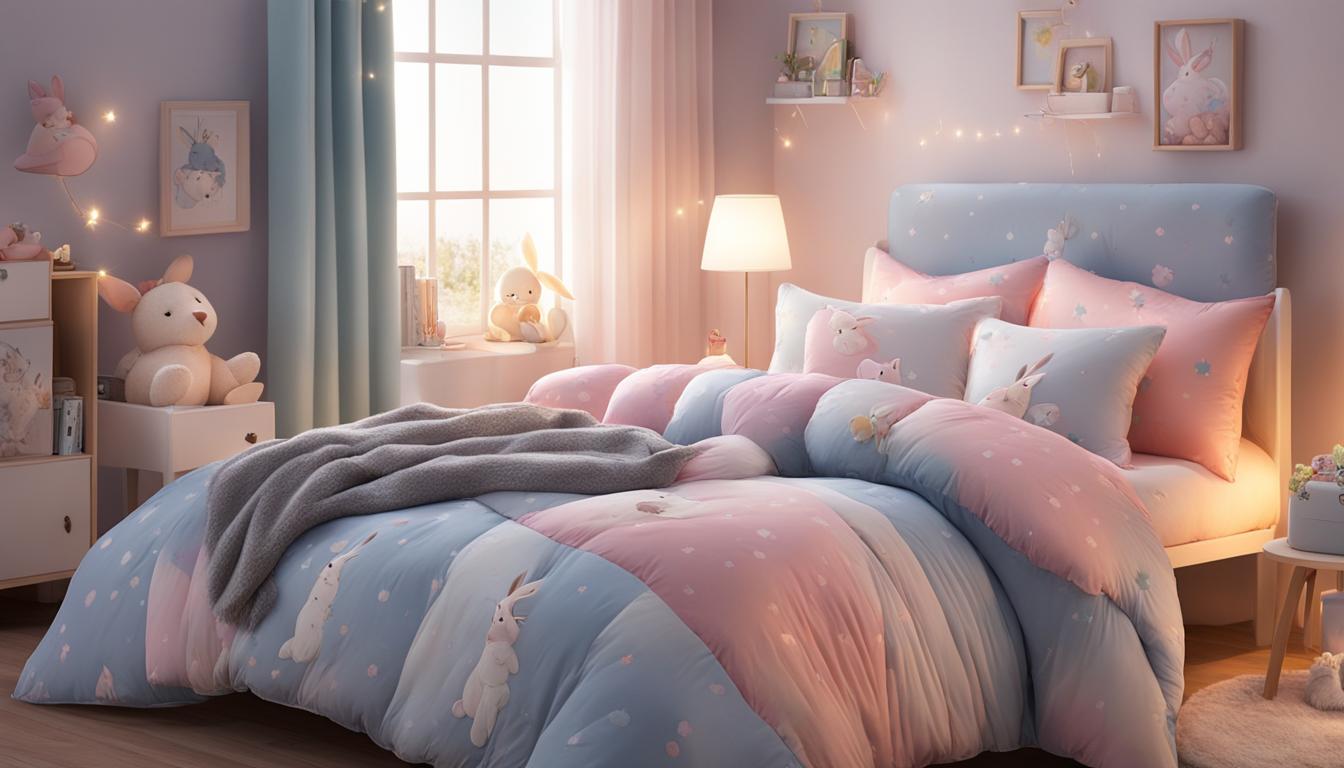Hypoallergenic Bedding for Sensitive Skin: The Ultimate Guide for Gentle Sleep!
Hypoallergenic Bedding for Sensitive Skin: Discover the Secret to a Perfect Night’s Sleep!
Sleep can be a struggle for individuals with sensitive skin, especially when the bedding isn’t hypoallergenic. Hypoallergenic bedding for sensitive skin helps reduce reactions to chemicals in traditional bedding.
Choosing the right bed sheets and bedding materials is essential for a good night’s sleep. Natural fibers such as TENCEL™, bamboo, silk, and cotton are recommended for sensitive skin.
Synthetic fibers like microfiber and polyester can irritate the skin. Bamboo and TENCEL™ are naturally hypoallergenic and antimicrobial, making them ideal for individuals with skin allergies.
Silk is suitable for dry skin, while organic cotton is free of chemicals and dyes, making it a good choice for sensitive skin. The weave method and certifications such as Oeko-Tex and GOTS also play a role in choosing suitable bedding for sensitive skin.
Key Takeaways:
- Choose hypoallergenic bedding for sensitive skin made from natural fibers like TENCEL™, bamboo, silk, and organic cotton.
- Avoid synthetic fibers such as microfiber and polyester.
- Consider bamboo and TENCEL™ for their hypoallergenic and antimicrobial properties.
- Silk is recommended for individuals with dry skin.
- Organic cotton is a good choice for sensitive skin due to its chemical-free and dye-free nature.
Continue reading to discover the best bed sheet materials for sensitive skin, materials to avoid, hygiene and certifications to prioritize, and additional tips for finding the right mattress and bedding for a comfortable and irritation-free sleep experience.
Best Hypoallergenic Bedding Materials for Sensitive Skin
When it comes to bedding materials for sensitive skin, choosing the right fabric can make all the difference in ensuring a comfortable and irritation-free sleep experience. Sensitive skin can react to harsh chemicals and synthetic fibers, leading to discomfort and skin irritations. To help you make an informed decision, we have compiled a list of the best bed sheet materials that are gentle on sensitive skin.
TENCEL™
TENCEL™ is an eco-friendly and sustainable fabric made from natural wood pulp. It has gained popularity for its softness, breathability, and hypoallergenic properties.
TENCEL™ sheets are smooth and gentle, making them perfect hypoallergenic bedding for sensitive skin. The fabric is also known for its excellent moisture management, keeping the skin dry and cool throughout the night. Its moisture-wicking properties make it less prone to bacteria growth, reducing the risk of skin irritation.
Bamboo
Bamboo bedding is another excellent choice for sensitive skin. Bamboo bedding is naturally hypoallergenic and antimicrobial, making it excellent hypoallergenic bedding for sensitive skin..
It is also highly breathable, allowing for better airflow and temperature regulation. Bamboo sheets are softer than cotton and have moisture-wicking properties, keeping the skin dry and comfortable. These qualities make bamboo a great option for individuals with sensitive skin or allergies.
Silk
Silk is a luxurious and delicate fabric, perfect for hypoallergenic bedding for sensitive skin. It is naturally breathable and has moisture-wicking properties, helping to regulate body temperature and prevent perspiration.
Silk is also known for its antimicrobial characteristics, making it suitable for individuals with skin conditions like eczema or dry skin. The smooth and gentle texture of silk can minimize friction against the skin, reducing any potential irritation.
Organic Cotton
Organic cotton is a popular choice for hypoallergenic bedding for sensitive skin due to its softness and chemical-free nature. It is free from harsh chemicals and dyes, making it gentle on the skin and less likely to cause irritation or allergic reactions.
Organic cotton bedding is also breathable, allowing for better airflow and moisture regulation. This helps to keep the skin dry and comfortable throughout the night.
By choosing bed sheet materials like TENCEL™, bamboo, silk, or organic cotton, individuals with sensitive skin can create a sleep environment that promotes comfort and reduces the risk of skin irritations. Remember to consider factors like breathability, moisture-wicking properties, and hypoallergenic characteristics when selecting bedding for sensitive skin.
Synthetic Fibers to Avoid for Sensitive Skin

When it comes to bedding for sensitive skin, avoiding synthetic fibers like microfiber and polyester is crucial. These man-made materials can irritate the skin and exacerbate skin conditions. Unlike natural fibers, synthetic fabrics are not breathable and can lead to moisture buildup, promoting bacteria growth and causing skin irritation. Therefore, individuals with sensitive skin should opt for bedding made from hypoallergenic natural fibers.
“Synthetic fabrics such as microfiber and polyester can cause skin irritation and moisture buildup, making them unsuitable for individuals with sensitive skin,” says Dr. Sarah Johnson, dermatologist.
“Choosing natural fibers like TENCEL™, bamboo, silk, and organic cotton is essential for individuals with sensitive skin. These materials are hypoallergenic, breathable, and moisture-wicking, keeping the skin dry, cool, and free from irritation,”
adds Dr. Johnson.
To create a safe and comfortable sleep environment for sensitive skin, it is best to avoid synthetic fibers and prioritize bedding made from natural materials.
Hygiene and Certifications for Sensitive Skin Bedding
When it comes to bedding for sensitive skin, maintaining proper hygiene is crucial. Regular cleaning and maintenance can help reduce allergens and irritants that may trigger skin reactions. Here are some hygiene practices to consider:
- Washing: It is important to wash your bedding regularly to keep it clean and free from allergens. Use mild, fragrance-free detergents and avoid fabric softeners, which may contain chemicals that can irritate sensitive skin.
- Dusting and Vacuuming: Dust and allergens can accumulate on your bedding over time. Regularly dust and vacuum your bedroom to minimize the presence of these irritants. Ensure that your vacuum cleaner has a HEPA filter to effectively capture allergens.
- Certifications: Look for bedding that has certifications to ensure its safety for sensitive skin. Two common certifications to consider are Oeko-Tex and GOTS (Global Organic Textile Standard). Oeko-Tex certification guarantees that the bedding is free of harmful substances, while GOTS certification ensures organic status from production to labeling.
By following these hygiene practices and choosing certified bedding, you can create a cleaner and healthier sleep environment for individuals with sensitive skin.
Table: Comparing Oeko-Tex and GOTS Certifications
| Certification | Oeko-Tex | GOTS |
|---|---|---|
| Description | Oeko-Tex certification ensures that the textile product is free from harmful substances and has been tested for safety. | GOTS certification guarantees that the textile product is made with organic fibers, meets stringent environmental and social criteria, and adheres to strict quality standards. |
| Chemical Restrictions | Restricts the use of harmful substances such as formaldehyde, heavy metals, and certain dyes. | Prohibits the use of toxic chemicals, including pesticides, synthetic dyes, and bleach. |
| Social Criteria | N/A | Requires fair labor practices and safe working conditions throughout the supply chain. |
| Environmental Criteria | N/A | Encompasses environmental considerations such as waste management, water usage, and energy consumption. |
By choosing bedding with these certifications, you can have peace of mind knowing that the materials are safe and produced with sustainable practices.
Benefits of Silk Bedding for Sensitive Skin
Silk bedding offers numerous benefits for individuals with sensitive skin, particularly those who suffer from conditions like eczema and dry skin. The unique properties of silk make it an ideal choice for creating a comfortable and irritation-free sleep environment.
Firstly, silk has natural antimicrobial properties that prevent the growth of bacteria on the bedding. This helps reduce skin inflammation and minimize the risk of infections, making it especially beneficial for individuals with eczema. Additionally, silk is highly breathable and moisture-wicking, meaning it can regulate body temperature and prevent excessive sweating that can lead to skin irritation. The smooth and soft texture of silk also prevents friction against the skin, reducing the likelihood of rashes and irritations.
| Benefits of Silk Bedding for Sensitive Skin | |
|---|---|
| Antimicrobial properties | Prevents bacteria growth |
| Breathable and moisture-wicking | Regulates body temperature |
| Smooth and soft texture | Prevents friction against the skin |
Furthermore, silk is hypoallergenic and resistant to common allergens such as dust mites, mold, and mildew. This makes it an excellent choice for individuals with allergies or sensitivities. Silk bedding can create a clean and hypoallergenic sleep environment, reducing the risk of allergic reactions and providing a peaceful night’s sleep.
In summary, silk bedding offers a range of benefits for individuals with sensitive skin, including its antimicrobial properties, breathability, and soft texture. It is particularly beneficial for those with conditions like eczema and dry skin. Investing in high-quality silk bedding can significantly improve sleep quality and overall comfort for individuals with sensitive skin.
Bamboo Bedding for Allergies and Dust Mites

For individuals with allergies and dust mite sensitivities, bamboo bedding is an excellent choice. Bamboo possesses natural properties that make it hypoallergenic and antimicrobial, reducing the presence of allergens and dust mites in the sleep environment. Its natural antimicrobial properties inhibit the growth of bacteria, fungi, and dust mites, making it a healthier choice for those with sensitivities.
Furthermore, bamboo bedding is highly breathable, allowing for optimal airflow and moisture regulation. This helps to keep the skin dry and cool, preventing the accumulation of moisture that can exacerbate allergic reactions. Bamboo’s breathability also aids in regulating body temperature, creating a comfortable and soothing sleep environment for individuals with allergies and sensitive skin.
Bamboo bedding is a game-changer for individuals struggling with allergies. Its natural properties not only reduce the presence of allergens and dust mites but also provide a cooler and more comfortable sleep experience.
The Benefits of Bamboo Bedding:
- Naturally hypoallergenic and antimicrobial
- Reduces allergens and dust mites in the sleep environment
- Highly breathable, ensuring optimal airflow and moisture regulation
- Helps regulate body temperature, promoting a comfortable sleep experience
Investing in bamboo bedding can significantly improve the sleep quality of individuals with allergies and dust mite sensitivities. By creating a cleaner and more comfortable sleep environment, bamboo bedding offers relief from allergens and promotes a restful and rejuvenating night’s sleep.
Organic Cotton Bedding for Chemical Sensitivities

For individuals with chemical sensitivities, finding bedding that is free of harmful chemicals and dyes is crucial for a comfortable and irritation-free sleep. Organic cotton bedding is a recommended choice for those with chemical sensitivities due to its natural and gentle properties. Organic cotton is grown without the use of synthetic pesticides or fertilizers, reducing the risk of exposure to harmful substances. It is also free of harsh dyes, ensuring that no additional chemicals come into contact with the skin.
The natural breathability of organic cotton allows for optimal airflow, keeping the skin cool and dry throughout the night. This is especially beneficial for individuals with chemical sensitivities, as it helps reduce the potential for sweating and skin irritation. Organic cotton bedding is also known for its soft and smooth texture, providing a comfortable sleep surface that is gentle on sensitive skin.
When choosing organic cotton bedding, look for products that are certified organic by trusted organizations such as the Global Organic Textile Standard (GOTS). This certification ensures that the entire production process, from harvesting the cotton to labeling the final product, meets strict organic standards. By opting for organic cotton bedding, individuals with chemical sensitivities can create a sleep environment that is free of harmful substances and promotes a restful night’s sleep.
| Benefits of Organic Cotton Bedding for Chemical Sensitivities: |
|---|
| – Free of harmful chemicals and dyes |
| – Breathable and moisture-wicking |
| – Soft and gentle on sensitive skin |
| – Certified organic by GOTS |
Finding the Right Mattress for Sensitive Skin
Choosing the right mattress is crucial for individuals with sensitive skin. Hypoallergenic mattresses made of natural materials are recommended to resist allergens and dust mites. Two popular options for sensitive skin are latex mattresses and memory foam mattresses.
Latex Mattress
A latex mattress is a great choice for individuals with allergies or sensitive skin. Latex is a natural material derived from rubber trees and is inherently hypoallergenic. It is resistant to allergens such as dust mites, mold, and mildew. Latex mattresses are also known for their durability and excellent support, providing a comfortable sleep surface for those with sensitive skin.
Memory Foam Mattress
Memory foam mattresses can also be a suitable option for sensitive skin, but it’s important to choose carefully. Some memory foam mattresses may retain body heat, leading to discomfort for hot sleepers. Look for memory foam mattresses that are designed with cooling properties, such as gel-infused or open-cell foam, to regulate temperature and prevent overheating. Additionally, opt for memory foam mattresses that are hypoallergenic and certified to be free of harmful chemicals.
Comparison of Latex and Memory Foam Mattresses
| Features | Latex Mattress | Memory Foam Mattress |
|---|---|---|
| Material | Natural latex derived from rubber trees | Synthetic or plant-based memory foam |
| Hypoallergenic | Yes | Varies, check for certifications |
| Support | Excellent support and responsiveness | Contouring and pressure relief |
| Temperature Regulation | Good breathability, but can retain more heat | Varies, look for cooling properties |
| Durability | Long-lasting | Varies, depends on foam quality |
When comparing latex and memory foam mattresses, consider factors such as material, hypoallergenic properties, support, temperature regulation, and durability. Carefully evaluate your specific needs and preferences to determine which mattress type is best suited for your sensitive skin.
Thread Count and Color Considerations for Sensitive Skin Bedding
When choosing bedding for sensitive skin, it’s important to consider factors like thread count and color. These seemingly small details can actually have a big impact on your sleep comfort and skin health. Let’s delve into why they matter.
Thread Count: Finding the Sweet Spot
Thread count refers to the number of threads woven into a square inch of fabric. While a high thread count is often associated with luxury, it may not be the best choice for sensitive skin. Sheets with thread counts above 600 often involve synthetic fabric processing, which can irritate the skin. For optimal comfort, aim for a thread count between 200 and 400. This range strikes a balance between softness, breathability, and durability, creating an ideal sleep surface for sensitive skin.
Color: Gentle Hues for Soothing Sleep
Color plays a role in the overall sensory experience of your sleep environment, especially for individuals with sensitive skin. Light-colored sheets are recommended to minimize skin irritation and allergic reactions. Avoid harsh dyes and opt for gentle hues like pastels or whites. These colors not only create a soothing visual aesthetic but also reduce the risk of skin irritation caused by chemical dyes.
| Thread Count | Color | |
|---|---|---|
| Low | Below 200 | White, pastels |
| Medium | 200-400 | Light shades, neutrals |
| High | Above 600 | Avoid synthetic dyes |
By considering thread count and color when selecting bedding for sensitive skin, you can create a sleep environment that promotes comfort and minimizes skin irritation. Remember, it’s not just about luxurious materials, but also about finding the right balance for your individual needs.
Recommended Hypoallergenic Bedding Brands and Products

When it comes to hypoallergenic bedding, several trusted brands offer a range of products that are perfect for individuals with sensitive skin. These brands prioritize the use of natural, hypoallergenic materials to ensure a comfortable and irritation-free sleep environment. Here are some recommended hypoallergenic bedding brands and their standout products:
1. Sleep & Co.
Sleep & Co. is a renowned brand that specializes in hypoallergenic bedding. Their TENCEL™ bed sheets are made from sustainably sourced eucalyptus fibers, ensuring breathability and moisture-wicking properties. These sheets are luxuriously soft and gentle on the skin, making them an excellent choice for individuals with sensitive skin. Sleep & Co. also offers a range of bamboo and organic cotton bedding options for those looking for alternative hypoallergenic materials.
2. PureSilk
PureSilk is a brand known for its high-quality silk bedding products. Their silk pillowcases and sheets are made from pure mulberry silk, which is hypoallergenic and naturally resistant to dust mites. The smooth texture of PureSilk bedding reduces friction and minimizes skin irritation, making it ideal for individuals with sensitive skin or conditions like eczema. The brand offers various silk bedding sets in different colors and sizes.
3. Cozy Sleep
Cozy Sleep is a trusted brand that focuses on providing organic and chemical-free bedding options. Their organic cotton bed sheets are made from GOTS-certified cotton, ensuring that no harmful chemicals or dyes are used in the production process. Cozy Sleep’s organic cotton bedding is soft, breathable, and gentle on sensitive skin. Additionally, the brand offers a range of hypoallergenic mattress protectors and pillow covers to complete your allergy-friendly sleep environment.
By investing in bedding from these reputable brands, individuals with sensitive skin can enjoy a peaceful and irritation-free sleep experience.
Remember to always check the product descriptions and customer reviews to find the right hypoallergenic bedding for your specific needs. Whether you prefer TENCEL™, silk, bamboo, or organic cotton, these brands have you covered with their high-quality, hypoallergenic products.
Conclusion
In conclusion, when it comes to bedding for sensitive skin, choosing hypoallergenic bedding for sensitive skin is essential. Natural fibers such as TENCEL™, bamboo, silk, and organic cotton are highly recommended. These materials are hypoallergenic, breathable, and moisture-wicking, providing a comfortable sleep environment for individuals with sensitive skin.
Avoid synthetic fibers like microfiber and polyester, as they can irritate the skin and worsen skin conditions. Opt for natural fibers that are gentle on the skin and help regulate body temperature during sleep.
Furthermore, prioritize hygiene and certifications when selecting bedding. Regular washing, dusting, and vacuuming can help reduce allergens and dust mites. Look for certifications such as Oeko-Tex and GOTS, which ensure that the bedding is free of harmful chemicals and meets strict standards for environmental and social responsibility.
Invest in quality hypoallergenic bedding brands that offer a range of products made from natural fibers. Consider factors like thread count and color to further minimize skin irritation and create a comfortable and irritation-free sleep environment. With the right hypoallergenic bedding, individuals with sensitive skin can enjoy a restful and gentle sleep.
By opting for hypoallergenic bedding for sensitive skin, individuals can ensure a comfortable and irritation-free sleep environment.
Hypoallergenic bedding for sensitive skin includes materials like TENCEL™, bamboo, silk, and organic cotton.
FAQ
What materials are recommended for sensitive skin bedding?
Natural fibers such as TENCEL™, bamboo, silk, and organic cotton are recommended for sensitive skin bedding.
What materials should be avoided for sensitive skin bedding?
Synthetic fibers like microfiber and polyester should be avoided for sensitive skin bedding.
What certifications should I look for in sensitive skin bedding?
Certifications such as Oeko-Tex and GOTS provide assurance that the bedding is free of harmful chemicals and meets strict environmental and social responsibility standards.
What are the benefits of silk bedding for sensitive skin?
Silk bedding has antimicrobial properties and is suitable for conditions like eczema and dry skin. It is also breathable and moisture-wicking.
Why is bamboo bedding recommended for allergies and dust mites?
Bamboo has natural antimicrobial and hypoallergenic properties, reducing allergens and dust mites in the sleep environment. It is also breathable and helps regulate body temperature.
How is organic cotton bedding beneficial for chemical sensitivities?
Organic cotton bedding is free of harmful chemicals and dyes, making it safe for individuals with chemical sensitivities. It is also breathable and helps reduce skin irritation.
What type of mattress is suitable for sensitive skin?
Hypoallergenic mattresses made of natural materials like latex or memory foam can resist allergens and dust mites. Latex mattresses are chemical-free and dust mite resistant, while memory foam mattresses should be chosen carefully for heat retention.
What thread count and color should I choose for sensitive skin bedding?
Opt for thread counts between 200 to 400 for optimal airflow and comfort. Choose light-colored sheets without harsh dyes to minimize skin irritation and allergic reactions.
Are there recommended hypoallergenic bedding brands for sensitive skin?
Yes, some recommended brands include those that offer TENCEL™, bamboo, silk, and organic cotton bedding.




